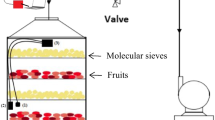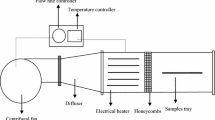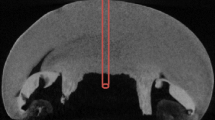Abstract
Several structural and physical changes in foodstuffs are the consequence of water removal during the drying process. Porosity (volume fraction of pores) is one of the key parameter that affects the quality and other properties of foods (such as apple and potato). To understand the effect of dehydration in apple and potato, in the present study an arbitrary small cubic volume element is considered which contains pores (intracellular spaces) distributed in it. Further, it is assumed that each pore in the cubic volume element is spherical. A mathematical relation is developed between porosity (volume fraction of pores) and pressure generated (due to contraction of cells during water removal) in outward direction on the surface of spherical elements containing pore. The developed relation is satisfactory in respect of experimental observations given in the literature. For the given pressure range, acquired porosity range is 0.1 to 0.92 for apple and 0.03 to 0.89 for potato which is matched with the existing experimental values. The results showed that the porosity is increasing with the increasing values of pressure, as expected, during moisture removal. Further, it is observed that the current porosity is depended on the initial porosity for both apple and potato.













Similar content being viewed by others
Abbreviations
- A 0 :
-
Radius of pores (internal radius) in undeformed configuration (μm)
- B 0 :
-
Radius of bulk material (external radius) in undeformed configuration (μm)
- A :
-
Radius of pores (internal radius) in deformed configuration (μm)
- B :
-
Radius of bulk material (external radius) in deformed configuration (μm)
- C :
-
Constant of integration
- F :
-
Function
- F :
-
Deformation gradient tensor
- x(x 1, x 2, x 3):
-
Particle position vector in undeformed configuration
- y(y 1, y 2, y 3):
-
Particle position vector in deformed configuration
- R :
-
Particle distance from the origin in undeformed configuration
- r :
-
Particle distance from the origin in deformed configuratio
- (R, Θ, Φ):
-
Particle position in undeformed configuration
- (r, θ, φ):
-
Particle position in deformed configuration
- W :
-
Strain energy function
- b, C 1, C 2 :
-
Material constants
- B :
-
Left Cauchy-Green deformation tensor
- V :
-
Left stretching tensor
- I 1 , I 2 , I 3 :
-
Invariants of left Cauchy-Green deformation tensor
- λ r , λ θ , λ φ :
-
Principal stretches
- τ :
-
Cauchy stress tensor
- τ rr , τ θθ :
-
Principal component of Cauchy stress
- ρ :
-
Hydrostatic pressure (kPa)
- p :
-
Pressure (a contraction stress generated in the cells due to water removal) (kPa)
- f 0 :
-
Initial porosity (volume fraction of pores)
- f :
-
Current porosity (volume fraction of pores)
- δ ij :
-
Kronecker delta
References
Bai Y, Rahman MS, Perera CO, Smith B, Melton LD (2002) Structural changes in apple rings during convection air-drying with controlled temperature and humidity. J Agric Food Chem 50:3179–3185. doi:10.1021/Jf011354s
Ball JM (1982) Discontinuous equilibrium solutions and cavitation in nonlinear elasticity. Philos Trans R Soc A 306:557–611. doi:10.1098/rsta.1982.0095
Chakraverty A, Mujumdar AS, Raghavan GSV, Ramaswamy HS (2003) Handbook of postharvest technology: cereals, fruits, vegetables, tea, and spices. CRC Press, New York
Chang CS (1988) Measuring density and porosity of grain kernels using a gas pycnometer. Cereal Chem 65:13–15
Chang WJ, Pan J (1997) Cavitation instabilities in plastics and rubber-modified plastics. Int J Fract 88:61–86. doi:10.1023/A:1007446104430
Chang WJ, Pan J (2001) Cavitation instability in rubber with consideration of failure. J Mater Sci 36:1901–1909. doi:10.1023/A:1017581420879
Dissa AO, Desmorieux H, Savadogo PW, Segda BG, Koulidiati J (2010) Shrinkage, porosity and density behaviour during convective drying of spirulina. J Food Eng 97:410–418. doi:10.1016/j.jfoodeng.2009.10.036
Holzapfel GA (2000) Nonlinear solid mechanics: a continuum approach for engineering. Wiley, Chichester
Hou HS (1990) Cavitation instability in solids, solid mechanics. Zhejiang University Hangzhou, China
Joardder MUH, Karim A, Kumar C (2014) Brown RJ Effect of cell wall properties of plant tissue on porosity and shrinkage of dried apple. In: Proceedings of the 2014 International Conference on Food Properties (ICFP2014)
Karathanos VT, Saravacos GD (1993) Porosity and pore size distribution of starch materials. J Food Eng 18:259–280 doi:10.1016/0260-8774(93)90090-7
Karathanos VT, Kanellopoulos NK, Belessiotis VG (1996) Development of porous structure during air drying of agricultural plant products. J Food Eng 29:167–183. doi:10.1016/0260-8774(95)00058-5
Katekawa ME, Silva MA (2004) Study of porosity behavior in convective drying of bananas. In: Proceedings of the 14th. International Drying Symposium (IDS 2004), Sao-Paulo, Brazil, 22–25 August 2004. pp 1427–1434
Khalloufi S, Almeida-Rivera C, Jansen J, Van-Der-Vaart M, Peter Bongers P (2011) Sensitivity of shrinkage and collapse functions involved in pore formation during drying. Paper presented at the 21st European Symposium on Computer Aided Process Engineering – ESCAPE 21
Koç B, Eren İ, Kaymak Ertekin F (2008) Modelling bulk density, porosity and shrinkage of quince during drying: the effect of drying method. J Food Eng 85:340–349. doi:10.1016/j.jfoodeng.2007.07.030
Krokida MK, Maroulis ZB (1997) Effect of drying method on shrinkage and porosity. Dry Technol 15:2441–2458. doi:10.1080/07373939708917369
Krokida MK, Maroulis ZB (1999) Effect of microwave drying on some quality properties of dehydrated products. Dry Technol 17:449–466. doi:10.1080/07373939908917545
Krokida M, Maroulis Z (2001) Quality changes during drying of food materials. In: Mujumdar AS (ed) Drying technology in agriculture and food science. Science Publishers, USA
Krokida MK, Zogzas NP, Maroulis ZB (1997) Modelling shrinkage and porosity during vacuum dehydration. Int J Food Sci Technol 32:445–458. doi:10.1111/j.1365-2621.1997.tb02119.x
Krokida MK, Karathanos VT, Maroulis ZB (1998) Effect of freeze-drying conditions on shrinkage and porosity of dehydrated agricultural products. J Food Eng 35:369–380. doi:10.1016/S0260-8774(98)00031-4
Krokida MK, Kiranoudis CT, Maroulis ZB (1999) Viscoelastic behaviour of dehydrated products during rehydration. J Food Eng 40:269–277. doi:10.1016/S0260-8774(99)00063-1
Krokida MK, Karathanos VT, Maroulis ZB (2000) Effect of osmotic dehydration on viscoelastic properties of apple and banana. Dry Technol 18:951–966. doi:10.1080/0737393000891 7746
Liu G, Chen J, Liu M, Wan X (2012) Shrinkage, porosity and density behaviour during convective drying of bio-porous material. Procedia Eng 31:634–640. doi:10.1016/j.proeng.2012.01.1078
Lopez-Pamies O, Idiart MI, Nakamura T (2011) Cavitation in elastomeric solids: I—a defect-growth theory. J Mech Phys Solids 59:1464–1487. doi:10.1016/j.jmps.2011.04.015
Lozano JE, Rotstein E, Urbicain MJ (1980) Total porosity and open-pore porosity in the drying of fruits. J Food Sci 45:1403–1407. doi:10.1111/j.1365-2621.1980.tb06564.x
Lozano JE, Rotstein E, Urbicain MJ (1983) Shrinkage, porosity and bulk-density of foodstuffs at changing moisture contents. J Food Sci 48:1497–1502 & 1553 doi: 10.1111/j.1365-2621.1983.tb03524.x
Madiouli J, Lecomte D, Nganya T, Chavez S, Sghaier J, Sammouda H (2007) A method for determination of porosity change from shrinkage curves of deformable materials. Dry Technol 25:621–628. doi:10.1080/07373930701227185
Madiouli J, Sghaier J, Lecomte D, Sammouda H (2012) Determination of porosity change from shrinkage curves during drying of food material. Food Bioprod Process 90:43–51. doi:10.1016/j.fbp.2010.12.002
Mattea M, Urbicain MJ, Rotstein E (1989) Computer-model of shrinkage and deformation of cellular tissue during dehydration. Chem Eng Sci 44:2853–2859. doi:10.1016/0009-2509(89)85095-X
Mavroudis NE, Gekas V, Sjoholm I (1998) Osmotic dehydration of apples. Shrinkage phenomena and the significance of initial structure on mass transfer rates. J Food Eng 38:101–123. doi:10.1016/S0260-8774(98)00090-9
May BK, Perre P (2002) The importance of considering exchange surface area reduction to exhibit a constant drying flux period in foodstuffs. J Food Eng 54:271–282. doi:10.1016/S0260-8774(01)00213-8
Mayor L, Sereno AM (2004) Modelling shrinkage during convective drying of food materials: a review. J Food Eng 61:373–386. doi:10.1016/S0260-8774(03)00144-4
Mayor L, Pissarra J, Sereno AM (2008) Microstructural changes during osmotic dehydration of parenchymatic pumpkin tissue. J Food Eng 85:326–339. doi:10.1016/j.jfoodeng.2007. 06.038
McMinn WAM, Magee TRA (1997) Physical characteristics of dehydrated potatoes - part I. J Food Eng 33:37–48. doi:10.1016/S0260-8774(97)00039-3
Murphy JG, Biwa S (1997) Nonmonotonic cavity growth in finite, compressible elasticity. Int J Solids Struct 34:3859–3872. doi:10.1016/S0020-7683(96)00237-5
Nieto AB, Salvatori DM, Castro MA, Alzamora SM (2004) Structural changes in apple tissue during glucose and sucrose osmotic dehydration: shrinkage, porosity, density and microscopic features. J Food Eng 61:269–278. doi:10.1016/S0260-8774(03)00108-0
Oikonomopoulou VP, Krokida MK (2012) Structural properties of dried potatoes, mushrooms, and strawberries as a function of freeze-drying pressure. Dry Technol 30:351–361. doi:10.1080/07373937.2011.639475
Oikonomopoulou VP, Krokida MK (2013) Novel aspects of formation of food structure during drying. Dry Technol 31:990–1007. doi:10.1080/07373937.2013.771186
Polignone DA, Horgan CO (1993) Cavitation for incompressible anisotropic nonlinearly elastic spheres. J Elast 33:27–65. doi:10.1007/bf00042634
Rahman MS (2001) Toward prediction of porosity in foods during drying: a brief review. Dry Technol 19:1–13. doi:10.1081/Drt-100001349
Rahman MS (2003) A theoretical model to predict the formation of pores in foods during drying. Int J Food Prop 6:61–72. doi:10.1081/Jfp-120016624
Rahman MS (2008) Food properties handbook, 2nd edn. CRC Press, Taylor & Francis Group, LLC, New York
Rahman MS, Perera CO, Chen XD, Driscoll RH, Potluri PL (1996) Density, shrinkage and porosity of calamari mantle meat during air drying in a cabinet dryer as a function of water content. J Food Eng 30:135–145. doi:10.1016/S0260-8774(96)00013-1
Rahman MS, Al-Zakwani I, Guizani N (2005) Pore formation in apple during air-drying as a function of temperature: porosity and pore-size distribution. J Sci Food Agric 85:979–989. doi:10.1002/Jsfa.2056
Ratti C (1994) Shrinkage during drying of foodstuffs. J Food Eng 23:91–105. doi:10.1016/0260-8774(94)90125-2
Sablani SS, Rahman MS (2002) Pore formation in selected foods as a function of shelf temperature during freeze drying. Dry Technol 20:1379–1391. doi:10.1081/Drt-120005857
Sahin S, Sumnu SG (2006) Physical properties of foods. Springer Science + Business Media, LLC., New York
Singh F, Katiyar VK, Singh BP (2013) A new strain energy function to characterize apple and potato tissues. J Food Eng 118:178–187. doi:10.1016/j.jfoodeng.2013.04.006
Singh F, Katiyar VK, Singh BP (2014) Analytical study of turgor pressure in apple and potato tissues. Postharvest Biol Technol 89:44–48. doi:10.1016/j.postharvbio.2013.11.007
Sinha NK (2011) Handbook of vegetables and vegetable processing. Wiley, USA
Sivaloganathan J (1986) Uniqueness of regular and singular equilibria for spherically symmetric problems of nonlinear elasticity. Arch Ration Mech Anal 96:97–136. doi:10.1007/ bf00251407
Suzuki K, Kubota K, Hasegawa T, Hosaka H (1976) Shrinkage in dehydration of root vegetables. J Food Sci 41:1189–1193. doi:10.1111/j.1365-2621.1976.tb14414.x
Wang N, Brennan JG (1995) Changes in structure, density and porosity of potato during dehydration. J Food Eng 24:61–76. doi:10.1016/0260-8774(94)P1608-Z
Weinberg IK (2007) Material modeling of microstructured solids, theory, numeric and applications. Technical University of Berlin
Zogzas NP, Maroulis ZB, Marinoskouris D (1994) Densities, shrinkage and porosity of some vegetables during air-drying. Dry Technol 12:1653–1666. doi:10.1080/073739394089 62191
Acknowledgments
One of the authors is very thankful to Council of Scientific & Industrial Research (CSIR) New Delhi, India for providing financial support during preparation of this manuscript. Authors also wishes to acknowledge Mrs. Ravita for her useful help during the development of this work.
Author information
Authors and Affiliations
Corresponding author
Appendices
Appendix A
In the terms of components, the deformation gradient tensor can be written as
where y = (y 1, y 2, y 3), x = (x 1, x 2, x 3), \( R=\left|\mathbf{x}\right|=\sqrt{\left({x}_1^2+{x}_2^2+{x}_3^2\right)} \) and
on substituting Eq. (A2) in Eq. (A1) and after some simplifications we can find
By using incompressibility condition Det(F) = 1 (from Eq. 5), Eq. (A3) can be solved to get
Appendix B
From Eq. (5) we have B 3 − B 30 = A 3 − A 30 , substituting the value of A 3 − A 30 in Eq. (13), we can get
Now, for r = B, Eq. (B1) reduced to
Again, substituting the value of B from Eq. (5) into Eq. (B2)
Rights and permissions
About this article
Cite this article
Singh, F., Katiyar, V.K. & Singh, B.P. Mathematical modeling to study influence of porosity on apple and potato during dehydration. J Food Sci Technol 52, 5442–5455 (2015). https://doi.org/10.1007/s13197-014-1647-5
Revised:
Accepted:
Published:
Issue Date:
DOI: https://doi.org/10.1007/s13197-014-1647-5




